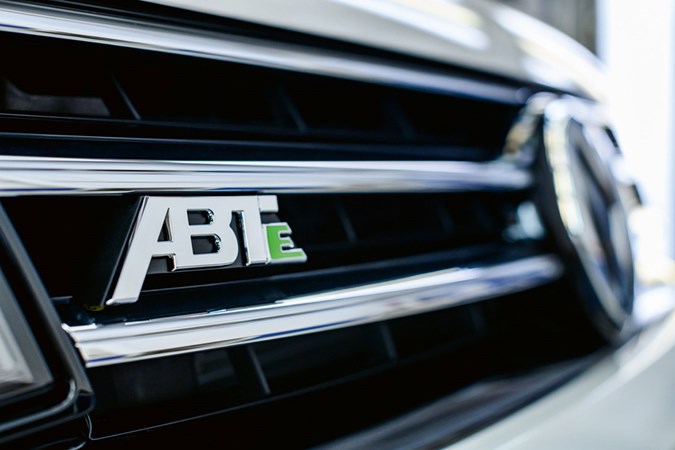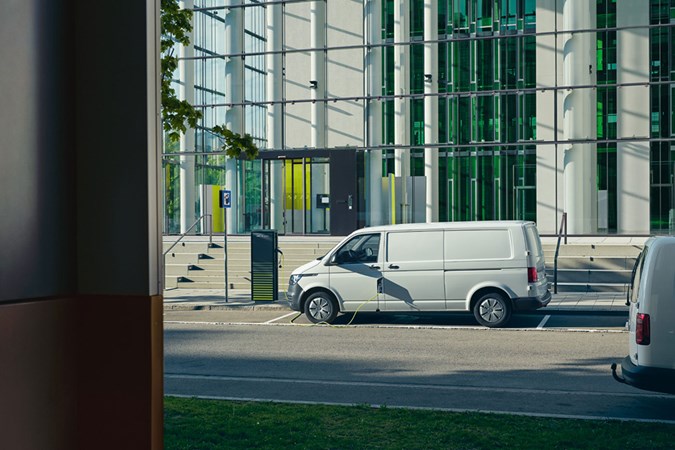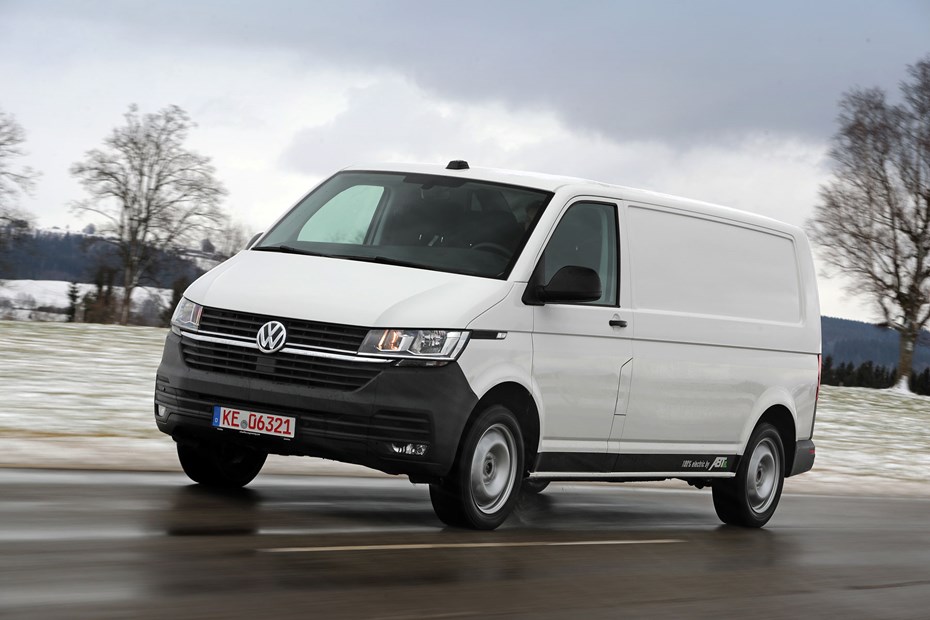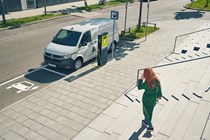UPDATE: to find out what this electric van is really like, read our full and comprehensive Volkswagen e-Transporter review.
The first Volkswagen van to be available with electric power in the UK is this new e-Transporter, which is priced from £42,060 (excluding VAT) and set to go on sale in the second half of 2020.
The e-Transporter joins what is suddenly a very busy medium-sized electric van market, facing-off against rivals including the Mercedes-Benz eVito and the Groupe PSA trio of Citroen e-Dispatch, Peugeot e-Expert and Vauxhall Vivaro-e.
So how does the e-Transporter electric van stack up against the competition? Keep reading for full UK details of Volkswagen’s new 100% electric van, including how it compares to those alternatives.
This is the first VW electric van?
Funny how the world works. Really, the e-Transporter should have been the third VW electric van available in the UK, but plans to bring in the e-Caddy were cancelled (as that generation of Caddy has been replaced by an all-new Caddy) and we’ve recently learned that the e-Crafter (announced back in 2017) won’t come to the UK until after that model is facelifted in around 2021.
So, the e-Transporter has ended up jumping the queue. Which makes sense, really, as the Transporter is VW Commercial Vehicle’s bestselling van in the UK. Even so, we still had to wait for the Transporter T6.1 facelift before we finally got a UK price. And it’s still not exactly built by Volkswagen.
Who builds the e-Transporter electric van?
VW has farmed the work out to ‘Premium Partner’ ABT e-Line – hence the van is officially called the Volkswagen ABT e-Transporter.
You might have heard of ABT, but possibly not in a commercial vehicle context – as this German company is better known for running racing teams and offering tuning packages for passenger cars (and vans). In this capacity its association with the wider VW Group goes back decades.
Among ABT’s most recent successes are race victories in the Formula E electric racing series, and it still runs the Audi Formula E team even now. It’s this race-proven electric-vehicle expertise that actually prompted VW Commercial Vehicles to turn to ABT as a quick-fix solution to putting electric versions of the Transporter and Caddy into production.

VW supplies complete vehicles to ABT, which then adapts them to electric power in its own factory. There are ABTe badges on the back and the grille.
The area of ABT that deals with electric vehicles is called ABT e-Line GmbH, while the motorsport and vehicle tuning arm is called ABT Sportsline GmbH. Both are part of the over-arching ABT Group.
What are the technical details of the VW e-Transporter electric van?
There are a few gaps here – which we’re trying to fill in – but here’s the technical info we have so far.
The e-Transporter is powered by an 83kW electric motor, equivalent to 110hp with 200Nm of torque. That doesn’t sound like much, but the way electric motors work means you’ll get all that torque as soon as you press the accelerator.
We don’t have a top speed yet, but it will go 0-62mph in 17.4 seconds, apparently.
Unusually, the e-Transporter uses a modified version of the regular Transporter’s DSG automatic transmission with three forward gears. Most electric vehicles – including every other electric van – have a single-speed transmission.
In regular Drive, the van will use 75% of the electric motor’s performance, reserving the full 100% for whenever ‘kickdown’ is activated.

All UK e-Transporters will be based on the long-wheelbase (LWB) Transporter, but buyers will be able to choose between panel van and kombi crew van bodystyles.
Originally, VW had planned to offer two battery pack sizes, but the info we have so far only gives driving range figures and charging times for a single battery pack option. This is the smaller option, which VW believes will be adequate for UK fleet use while helping to keep costs down and maximise payload.
What’s the driving range of the e-Transporter electric van?
Ready for the bad news? The VW e-Transporter’s official driving range is just 82 miles.
Admittedly that’s tested to the latest WLTP standards – which are tougher than the old NEDC tests – but that is a big reduction over the 250-mile maximum range we were originally promised for this electric van. Even the single battery version was supposed to achieve 134 miles per charge under NEDC.
Again, VW believes the e-Transporter will offer adequate range for the way people will use it.
How long does it take to charge the VW e-Transporter?
Able to use CCS (Combined Charging Services) or Type 2 charging systems, the e-Transporter has the flexibility to use DC and AC charging – although you only get the Type 2 cable as standard.
The CCS / DC charging system is the fastest, allowing owners and operators to take advantage of 50kW charging points, which will give you an 80% charge in ‘approximately 45 minutes’.
The Type 2 / AC charger is compatible with so-called wallbox charging points, as typically installed at home, and rated to 7.2kW max. At 7.2kW you’ll get a full charge in around 5 hours 30 minutes.
What’s the payload of the e-Transporter?
Maximum payload for the VW e-Transporter is 1,001kg.
This has fallen a bit, as we were previously promised up to 1,186kg.

The e-Transporter’s load area dimensions are the same as any other Transporter, as the batteries are mounted under the floor; this gives a maximum load volume of 6.7 cubic metres.
For full details see our dedicated VW e-Transporter dimensions page.
How much does the VW e-Transporter electric van cost?
Prices start at £42,060 for the basic panel van, with a new Advance specification, unique to the e-Transporter electric van (and named to match the trim level used by VW’s electrified car range), which adds a load of extra equipment and costs from £43,360.
If you want a kombi crew van you’re looking at £46,375 for the standard model, £49,985 for the Advance. All prices exclude VAT.
It’s on sale now.
How does the VW e-Transporter compare with rival electric vans?
Not especially well, as it turns out.
The Vauxhall Vivaro-e, Peugeot e-Expert or Citroen e-Dispatch all exceed the capability of the Volkswagen e-Transporter on every measure, offering up to 205 miles of driving range (WLTP), up to 1,226kg of payload, faster charging (100kW capable), 136hp electric motors and a choice of body sizes.
Things don’t look very good versus the Mercedes-Benz eVito, either. While the Mercedes also falls rather short of the PSA Group triplets – which will also form the basis of a Toyota Proace electric van – as it only offers a 93-mile driving range and 923kg maximum payload, the eVito costs less than the e-Transporter and comes in a wider range of sizes.
It seems this is one area where Volkswagen has fallen a little behind the opposition – though as you’ll find out if you read our full review, the e-Transporter is particularly nice to drive. Just a shame it isn’t more practical.
Also read:
>> Our full Volkswagen ABT e-Transporter review
>> The best electric vans you can buy now
>> The Parkers guide to electric vans
>> Future electric vans coming soon
Just so you know, we may receive a commission or other compensation from the links on this website - read why you should trust us.










